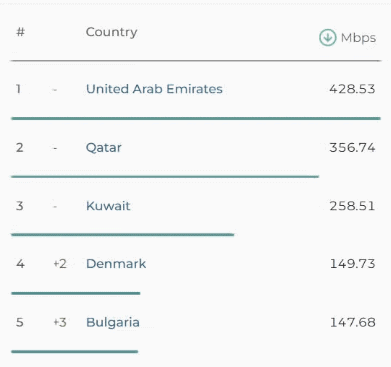Asia, Middle East Take the Lead in Internet Speed Rankings for 2024

Asia and the Middle East continue to lead the global rankings in mobile internet speeds, outpacing powerful nations like the United States. Since 2018, 1.5 billion people have come online, yet the digital divide persists, with significant disparities in speed and data usage across regions.
High-income countries experience median mobile broadband speeds that are five times greater than those found in low-income nations, and they generate twenty times more data traffic per capita. Despite this, the most recent findings from Ookla’s Speedtest Global Index, which utilizes data gathered until October 2024, indicate significant changes in global rankings.

The United Arab Emirates and Qatar maintain their leading positions, while Kuwait has made an unexpected advancement to the third position. Kuwait’s median download speed of 258.51 Mbps now positions it among the foremost mobile internet providers, representing a significant enhancement from 2023, when it failed to secure a place within the top five.
Denmark and Bulgaria have ascended into the top five rankings, with Denmark advancing two positions to attain a median bandwidth of 149.73 Mbps. Concurrently, Bulgaria ascended three positions to establish its standing within the prestigious group. South Korea, which was previously a leading competitor, has now completely exited the top five rankings.
In contrast, Pakistan is positioned 100th in the world regarding mobile internet capabilities, exhibiting a median download speed of 20.61 Mbps. In the realm of broadband connectivity, Pakistan ranks 141st, with a median download speed of 15.6 Mbps. However, the nation has demonstrated modest advancement, ascending two positions in the broadband rankings.
These rankings underscore the increasing digital divide between high-income and low-income countries. As the Middle East and Asia establish benchmarks for mobile internet speeds, regions that are currently languishing must confront infrastructure challenges to remain competitive in the digital era.
As mobile internet becomes progressively essential, global attention is focused on how these changes in speed and accessibility will influence connectivity in the upcoming years.
Sharing clear, practical insights on tech, lifestyle, and business. Always curious and eager to connect with readers.


 2 min read
2 min read
















